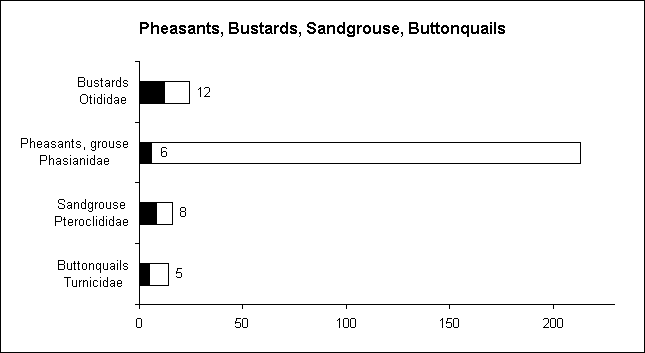
| Birds | < Waterbirds > | Reptiles |
| Seabirds | ||
| Bustards | ||
| Raptors | ||
| Songbirds | ||
| Other groups |
The great bustard (Otis tarda) and the Houbara bustard (Chlamydotis undulata) are target species for several conservation initiatives, including a Memorandum of Understanding by CMS (Figures A2.68, A2.69). Both species still occupy a wide palaearctic range. The distinct populations and subspecies differ with respect to their migratory behaviour, and suffer from a wide variety of threats. A detailed analysis revealed habitat loss, low breeding success, predation, collision with powerlines and human disturbance as major threats for European populations of Otis tarda (Heredia et al. 1996, p. 245). For the sedentary Canary Island population of the Houbara (Chalmydotis undulata fuertaventurae), habitat

|
Fig. 4.9: Number of migratory pheasants, bustards, sandgrouse and buttonquails. Total bar: species numbers within the family, |
Abb. 4.9: Anzahl der wandernden Arten innerhalb der Fasane, Trappen, Flughühner und Wachtellaufhühnchen. Balken (gesamt): Artenzahlen innerhalb einer Familie, |
loss and disturbance by tourism were identified as main threats (l.c., p. 261), while hunting, trapping and agricultural intensification are affecting the other two subspecies (Figure A2.68, and references therein). Six additional species of the small family Otididae are migrants (Figure 4.9). Both Asian species of floricans (Eupodotis spp.) are "Endangered", and therefore require urgent protection. Though their migratory behaviour is not well-known, they are candidates for listing by CMS
(Table 4.8).
| Birds | < Waterbirds > | Reptiles |
| Seabirds | ||
| Bustards | ||
| Raptors | ||
| Songbirds | ||
| Other groups |
This document should be quoted as part of the publication "Riede, K. (2001): The Global Register of Migratory Species Database, GIS Maps and Threat Analysis. Münster (Landwirtschaftsverlag), 400 pp." + CD
by Klaus Riede